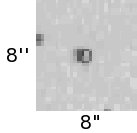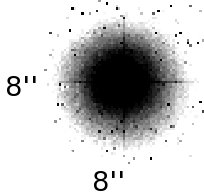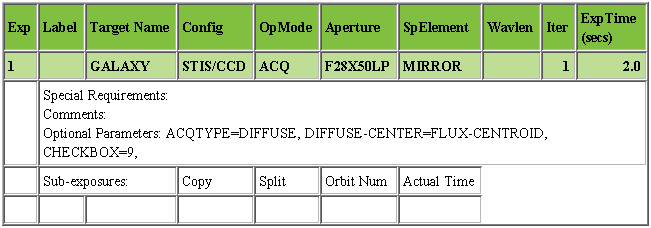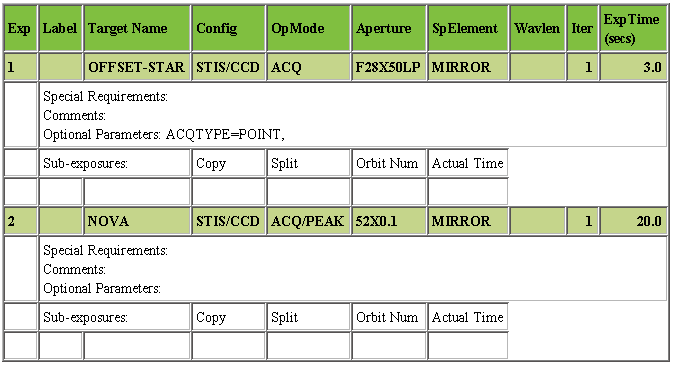8.5 Acquisition Examples
The following are examples of how to determine the acquisition scenario, and how to derive the correct exposure times. Each example shows an image of the target, the input parameters for the ETCs, and the parameters that you will need to provide in your Phase II proposal.
Note that the final numbers in the examples in this section are from a previous version of the ETC and will not match up exactly if rerunning these calculations with the current ETC.
Note also that the APT preview format used throughout this section may not be the one in use at the time you are crafting your proposal.
8.5.1 Point Source Acquisition of an Isolated Object
In this first example an isolated V = 19 mag QSO (z = 1.5) is to be acquired, with the scientific exposures to be obtained in the 52X0.5 slit.
The target is isolated, so it will be acquired with a point source acquisition. The object is faint, so we can use the preferred F28X50LP filter. The TA ETC is then used to determine an exposure time of 11.4 seconds. Note that the GAIN=4 and CR-SPLIT=1 must be used for the ETC to ensure that you have a S/N of at least 40 in each of the two images obtained during the ACQ process. The object does not saturate the CCD, and the exposure time is less than 5 minutes, so we have devised a valid target acquisition. Given that the exposure time is so short, we can lengthen the time to 15.0 seconds (which yields a peak value of 1600 electrons, well below saturation) to make certain we have enough signal for a good acquisition. Since the data are being obtained in a wide slit, we do not need to perform an ACQ/PEAKUP, and our acquisition is complete.
Target Acquisition ETC Parameters - ACQ
- Detector - CCD;
- Filter - LongPass;
- Gain = 4 e–/ADU;
- Check Box - 3 x 3;
- Target was a point source;
- Spectrum: QSO with z = 1.5;
- Source Flux: V = 19;
- Average Galactic Extinction of E(B-V) = 0.0;
- The Zodical Light is average;
- The earthshine is average;
Phase II Parameters for ACQ Exposure:
8.5.2 Point Source Acquisition of Bright, Isolated Object with CCD Dispersed Light Peakup
In this example—point source acquisition of a bright, isolated object with a CCD dispersed light peakup—an isolated V = 3.5 mag M2 I star is to be acquired, with the scientific exposures to be obtained in the 0.2X0.06 echelle slit.
The scientific target will be acquired with a point source acquisition, but because the object is so bright, we cannot use the preferred F28X50LP filter. Instead, we will use the F28X50OII filter, and the TA ETC yields an exposure time of 0.06 second, which is less than the minimum allowed time of 0.1 second. Note that the GAIN=4 and CR-SPLIT=1 must be used for the ETC to assure that you have a S/N of at least 40 in each of the two images obtained during the ACQ process. We will increase the exposure time to 1.0 second. The object does not saturate the CCD, and the exposure time is less than 5 minutes, so we have devised a valid target acquisition.
The data are being obtained in a narrow slit, so we need to perform an ACQ/PEAK acquisition. The target is far too bright to perform the peakup with the MIRROR, so we will do a dispersed light peakup. Since we cannot perform a CCD peakup with an echelle grating, we will use the G430M grating with the CCD and the program slit (0.2X0.06); note that for an ACQ/PEAK, this combination is allowed. For a 1 second exposure with 1 × 1 binning, the ETC gives a peak count of 4279 electrons (well below saturation) and a total count of 5.8 × 104 electrons.
Target Acquisition ETC Parameters - ACQ:
- Detector = CCD;
- Filter = O
II; - Gain = 4 e–/ADU;
- Check Box = 3 x 3;
- Target was a point source;
- Spectrum: M2I (Model Spectrum);
- Source Flux: V = 3.5;
- Average Galactic Extinction of E(B-V) = 0.0;
- The Zodical Light is average;
- The earthshine is average;
Spectroscopic ETC Parameters - ACQ/PEAK:
- Grating = g430m;
- Central Wavelength = 4194;
- Slit =
0.2X0.06; - Specified Wavelength = 4194.1 angstroms;
- Gain = 4 e–/ADU;
- CR-SPLIT (Total number of images) = 1;
- Target was a point source;
- Spectrum: M2 I (Model Spectrum);
- Source Flux: V = 3.5;
- Average Galaxtic Extinction of E(B-V) = 0.0;
- The Zodical Light is average;
- The earthshine is average;
Phase II Parameters for ACQ and ACQ/PEAK Exposures:
8.5.3 Diffuse Source Acquisition of a Spiral Galaxy
In this example an isolated galaxy with a flux of 1.5 × 10–14 erg/cm2/s /Å/arcsec2 at 8000 Å is to be acquired, with the scientific exposures to be obtained in the 52X0.2 slit.
The target is isolated, so it will be acquired using a diffuse-source acquisition. After trying various checkbox sizes in the TAS (the image is from WFPC2), we determine that the appropriate CHECKBOX size is 9, and that we will use the FLUX-CENTROID algorithm. The object is faint, so we can use the preferred F28X50LP filter. The TA ETC is then used to determine an exposure time of 0.21 second. Note that the GAIN=4 and CR-SPLIT=1 must be used for the ETC to ensure that you have a S/N of at least 40 in each of the two images obtained during the ACQ process. The object does not saturate the CCD, and the exposure time is less than 5 minutes, so we have devised a valid target acquisition. Given that the exposure time is so short, we can lengthen it to 2.0 seconds to make certain we have enough signal for a good acquisition. Since the data are being obtained in a wide slit, we do not need to perform an ACQ/PEAKUP, and our acquisition is complete.
Target Acquisition ETC Parameters - ACQ:
- Detector - CCD;
- Filter = LongPass;
- Gain = 4 e–/ADU;
- Check Box = 9 x 9;
- Target was an extended source with a diameter of 3 arcseconds;
- Spectrum: Spiral Spectrum;
- Source Flux: 1.5 e–14 erg/cm–2/s/Å at 8000 Å;
- Average Galactic Extinction of E(B-V) = 0.0;
- The Zodical Light is average;
- The earthshine is average;
Phase II Parameters for ACQ Exposure:
8.5.4 Point Source Acquisition in a Crowded Field
In this example a V = 19 mag nova in a field with a brighter companion is to be acquired, with the scientific exposures to be obtained in the 52X0.1 slit. We have a spectrum of the nova that we will use to perform the exposure time calculations, according to the ETC instructions.
The target is in a crowded field and the on-board acquisition procedure will acquire the brightest object in the field, not our target. If a ground-based image were the only image of this field available and the spectral types of the neighboring stars were unknown, then an isolated offset star outside of the immediate field of the nova would need to be acquired. However, the above image was obtained with WFPC2 and the F555W filter, which has a similar bandpass to the STIS F28X50LP filter. We therefore know that the object to the southeast of the nova is clearly the brightest object in the field (V = 16.5), and it will be our acquisition object. The object is faint enough that we can use the preferred F28X50LP filter. Since we do not know the spectral type of the acquisition star, we will make a worst-case (i.e., fewest counts) assumption that the star is of spectral type O5 and unreddened. The TA ETC is then used to determine an exposure time of 2.0 seconds. Note that the GAIN=4 and CR-SPLIT=1 must be used for the ETC to ensure that you have a S/N of at least 40 in each of the two images obtained during the ACQ process. The object does not saturate the CCD, and the exposure time is less than 5 minutes, so we have devised a valid target acquisition. Note that since we do not know the spectral type of the object, we need to confirm that if the star had a spectral type of M6 V (which gives the most counts in the F28X50LP bandpass), it would still not saturate. Given that the exposure time is so short, we can lengthen it to 3.0 seconds to make certain we have enough signal for a good acquisition.
After acquiring the offset star, we need to slew the telescope to the nova, and since the data will be taken with a narrow slit, we need to perform an ACQ/PEAK acquisition. The peakup will be performed in the program slit (52X0.1), and we will use the CCD and the MIRROR. A 1 second exposure with 1 × 1 binning yields 655 electrons in the central 25 pixels of the target, so an exposure time of 8 seconds yields 5240 electrons, which meets the minimum requirement of 5000 electrons. We then need to lengthen the exposure time to 20 seconds to ensure we get more than the minimum required. The object does not saturate the CCD, and the exposure time is less than 7.6 minutes (the maximum time for a peakup with the 52X0.1 slit), so we have devised a valid peakup target acquisition.
Target Acquisition ETC Parameters - ACQ:
- Detector = CCD;
- Filter = LongPass;
- Gain = 4 e–/ADU;
- Check Box = 3 x 3;
- Target was a point source;
- Spectrum: O5V (Model Spectrum);
- Source Flux: V = 16.5;
- Average Galactic Extinction of E(B-V) = 0.0;
- The Zodical Light is average;
- The earthshine is average;
Imaging ETC Parameters - ACQ/PEAK:
- Detector = CCD;
- Filter = Clear;
- Gain = 4 e–/ADU;
- CR-SPLIT (Total number of images) = 1;
- Target was a point source;
- Spectrum: nova (User's);
- Source Flux: V = 19;
- Average Galactic Extinction of E(B-V) = 0.0;
- The Zodiacal Light is average;
- the earthshine is average;
Phase II Parameters for ACQ and ACQ/PEAK Exposures:
8.5.5 Point Source Acquisition of a QSO with Fuzz Behind the Fiducial Bar
In this example an isolated V = 16.5 mag QSO (z = 0.2) is to be acquired, with the scientific exposures to be obtained with the QSO behind the 52X0.2F1 fiducial bar.
The target is isolated, so it will be acquired using a point source acquisition. The object is faint, so we can use the preferred F28X50LP filter. The TA ETC is then used to determine an exposure time of 2.2 seconds. Note that the GAIN=4 and CR-SPLIT=1 must be used for the ETC to ensure that you have a S/N of at least 40 in each of the two images obtained during the ACQ process. The object does not saturate the CCD, and the exposure time is less than 5 minutes, so we have devised a valid target acquisition. Given that the exposure time is so short, we can lengthen it to 3.0 seconds to make certain we have enough signal for a good acquisition.
The 52X0.2F1 aperture is wide enough that a peakup is not needed. The occulting bar is even wider (0.5 arcsecond), so the ACQ exposure should place the target behind the occulting bar.
Target Acquisition ETC Parameters - ACQ:
- Detector = CCD
- Filter = LongPass
- Gain = 4 e–/ADU
- Check Box = 3 x 3
- Target was a point source
- Spectrum: QSO with z = 0.2
- Source Flux: V = 16.5
- Average Galactic Extinction of E(B-V) = 0.0
- The Zodical Light is average
- The earthshine is average
Phase II Parameters for ACQ Exposure:
8.5.6 Point Source Acquisition of a Bright, Isolated Star into the Wedge
In this example an isolated V = 6.0 mag G2 V star is to be acquired, with the scientific exposures to be obtained with the star behind the WEDGEA1.8 mask.
The target will be acquired with a point source acquisition, but because the object is so bright, we cannot use the preferred F28X50LP filter. Instead, we will use the F25ND3 neutral-density filter, and the TA ETC yields an exposure time of 0.02 second, which is less than the minimum allowed time of 0.1 second. Note that the GAIN=4 and CR-SPLIT=1 must be used for the ETC to assure that you have a S/N of at least 40 in each of the two images obtained during the ACQ process. We will therefore increase the exposure time to 0.5 second. The object does not saturate the CCD, and the exposure time is less than 5 minutes, so we have devised a valid target acquisition.
The star is to be accurately placed behind the WEDGE which is 1.8 arcseconds in size and in this example, we will perform an ACQ/PEAK acquisition. The peakup will be performed in the 0.3X0.05ND slit (peakdown acquisitions are not recommended, see Section 12.10), and we will use the CCD and the MIRROR.1 A 1 second exposure yields 47,000 electrons in the target after you correct it for the aperture throughput [both the neutral-density (10–3) and the slit throughput (55%)]. We have more than the minimum requirement of 5000 electrons in the target, the object does not saturate the CCD, and the exposure time is less than 6.4 minutes (the maximum time for a peakup with the 0.3X0.05ND slit), so we have devised a valid peakup target acquisition.
Target Acquisition ETC Parameters - ACQ:
- Detector = CCD;
- Filter = ND3;
- Gain = 4 e–/ADU;
- Check Box = 3 x 3;
- Target was a point source;
- Spectrum: G2V (Model Spectrum);
- Source Flux: V = 6.0;
- Average Galactic Extinction of E(B-V) = 0.0;
- The Zodical Light is average;
- The earthshine is average;
Imaging ETC Parameters - ACQ/PEAK:
- Detector = CCD;
- Filter = Clear;
- Gain = 4 e–/ADU;
- CR-SPLIT (Total number of images) = 1;
- Target was a point source;
- Spectrum:G2V (Model Spectrum);
- Source Flux: V = 6.0;
- Average Galactic Extinction of E(B-V) = 0.0;
- The Zodical Light is average;
- The earthshine is average;
Phase II Parameters for ACQ and ACQ/PEAK Exposures:
1 Note that peak-ups are only really needed if the PI wants a pointing accuracy better than ~13 mas.
-
STIS Instrument Handbook
- • Acknowledgments
- Chapter 1: Introduction
-
Chapter 2: Special Considerations for Cycle 33
- • 2.1 Impacts of Reduced Gyro Mode on Planning Observations
- • 2.2 STIS Performance Changes Pre- and Post-SM4
- • 2.3 New Capabilities for Cycle 33
- • 2.4 Use of Available-but-Unsupported Capabilities
- • 2.5 Choosing Between COS and STIS
- • 2.6 Scheduling Efficiency and Visit Orbit Limits
- • 2.7 MAMA Scheduling Policies
- • 2.8 Prime and Parallel Observing: MAMA Bright-Object Constraints
- • 2.9 STIS Snapshot Program Policies
- Chapter 3: STIS Capabilities, Design, Operations, and Observations
- Chapter 4: Spectroscopy
- Chapter 5: Imaging
- Chapter 6: Exposure Time Calculations
- Chapter 7: Feasibility and Detector Performance
-
Chapter 8: Target Acquisition
- • 8.1 Introduction
- • 8.2 STIS Onboard CCD Target Acquisitions - ACQ
- • 8.3 Onboard Target Acquisition Peakups - ACQ PEAK
- • 8.4 Determining Coordinates in the International Celestial Reference System (ICRS) Reference Frame
- • 8.5 Acquisition Examples
- • 8.6 STIS Post-Observation Target Acquisition Analysis
- Chapter 9: Overheads and Orbit-Time Determination
- Chapter 10: Summary and Checklist
- Chapter 11: Data Taking
-
Chapter 12: Special Uses of STIS
- • 12.1 Slitless First-Order Spectroscopy
- • 12.2 Long-Slit Echelle Spectroscopy
- • 12.3 Time-Resolved Observations
- • 12.4 Observing Too-Bright Objects with STIS
- • 12.5 High Signal-to-Noise Ratio Observations
- • 12.6 Improving the Sampling of the Line Spread Function
- • 12.7 Considerations for Observing Planetary Targets
- • 12.8 Special Considerations for Extended Targets
- • 12.9 Parallel Observing with STIS
- • 12.10 Coronagraphic Spectroscopy
- • 12.11 Coronagraphic Imaging - 50CORON
- • 12.12 Spatial Scans with the STIS CCD
-
Chapter 13: Spectroscopic Reference Material
- • 13.1 Introduction
- • 13.2 Using the Information in this Chapter
-
13.3 Gratings
- • First-Order Grating G750L
- • First-Order Grating G750M
- • First-Order Grating G430L
- • First-Order Grating G430M
- • First-Order Grating G230LB
- • Comparison of G230LB and G230L
- • First-Order Grating G230MB
- • Comparison of G230MB and G230M
- • First-Order Grating G230L
- • First-Order Grating G230M
- • First-Order Grating G140L
- • First-Order Grating G140M
- • Echelle Grating E230M
- • Echelle Grating E230H
- • Echelle Grating E140M
- • Echelle Grating E140H
- • PRISM
- • PRISM Wavelength Relationship
-
13.4 Apertures
- • 52X0.05 Aperture
- • 52X0.05E1 and 52X0.05D1 Pseudo-Apertures
- • 52X0.1 Aperture
- • 52X0.1E1 and 52X0.1D1 Pseudo-Apertures
- • 52X0.2 Aperture
- • 52X0.2E1, 52X0.2E2, and 52X0.2D1 Pseudo-Apertures
- • 52X0.5 Aperture
- • 52X0.5E1, 52X0.5E2, and 52X0.5D1 Pseudo-Apertures
- • 52X2 Aperture
- • 52X2E1, 52X2E2, and 52X2D1 Pseudo-Apertures
- • 52X0.2F1 Aperture
- • 0.2X0.06 Aperture
- • 0.2X0.2 Aperture
- • 0.2X0.09 Aperture
- • 6X0.2 Aperture
- • 0.1X0.03 Aperture
- • FP-SPLIT Slits 0.2X0.06FP(A-E) Apertures
- • FP-SPLIT Slits 0.2X0.2FP(A-E) Apertures
- • 31X0.05ND(A-C) Apertures
- • 0.2X0.05ND Aperture
- • 0.3X0.05ND Aperture
- • F25NDQ Aperture
- 13.5 Spatial Profiles
- 13.6 Line Spread Functions
- • 13.7 Spectral Purity, Order Confusion, and Peculiarities
- • 13.8 MAMA Spectroscopic Bright Object Limits
-
Chapter 14: Imaging Reference Material
- • 14.1 Introduction
- • 14.2 Using the Information in this Chapter
- 14.3 CCD
- 14.4 NUV-MAMA
-
14.5 FUV-MAMA
- • 25MAMA - FUV-MAMA, Clear
- • 25MAMAD1 - FUV-MAMA Pseudo-Aperture
- • F25ND3 - FUV-MAMA
- • F25ND5 - FUV-MAMA
- • F25NDQ - FUV-MAMA
- • F25QTZ - FUV-MAMA, Longpass
- • F25QTZD1 - FUV-MAMA, Longpass Pseudo-Aperture
- • F25SRF2 - FUV-MAMA, Longpass
- • F25SRF2D1 - FUV-MAMA, Longpass Pseudo-Aperture
- • F25LYA - FUV-MAMA, Lyman-alpha
- • 14.6 Image Mode Geometric Distortion
- • 14.7 Spatial Dependence of the STIS PSF
- • 14.8 MAMA Imaging Bright Object Limits
- Chapter 15: Overview of Pipeline Calibration
- Chapter 16: Accuracies
-
Chapter 17: Calibration Status and Plans
- • 17.1 Introduction
- • 17.2 Ground Testing and Calibration
- • 17.3 STIS Installation and Verification (SMOV2)
- • 17.4 Cycle 7 Calibration
- • 17.5 Cycle 8 Calibration
- • 17.6 Cycle 9 Calibration
- • 17.7 Cycle 10 Calibration
- • 17.8 Cycle 11 Calibration
- • 17.9 Cycle 12 Calibration
- • 17.10 SM4 and SMOV4 Calibration
- • 17.11 Cycle 17 Calibration Plan
- • 17.12 Cycle 18 Calibration Plan
- • 17.13 Cycle 19 Calibration Plan
- • 17.14 Cycle 20 Calibration Plan
- • 17.15 Cycle 21 Calibration Plan
- • 17.16 Cycle 22 Calibration Plan
- • 17.17 Cycle 23 Calibration Plan
- • 17.18 Cycle 24 Calibration Plan
- • 17.19 Cycle 25 Calibration Plan
- • 17.20 Cycle 26 Calibration Plan
- • 17.21 Cycle 27 Calibration Plan
- • 17.22 Cycle 28 Calibration Plan
- • 17.23 Cycle 29 Calibration Plan
- • 17.24 Cycle 30 Calibration Plan
- • 17.25 Cycle 31 Calibration Plan
- • 17.26 Cycle 32 Calibration Plan
- Appendix A: Available-But-Unsupported Spectroscopic Capabilities
- • Glossary








